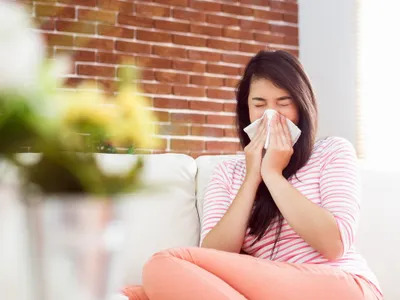Preventive Healthcare
Dust Allergy: Symptoms, Causes and Treatment
7670 Views
0

How often have you cleaned your home only to see dust and lint in the corners again the next minute? Dust is everywhere: in your houses, offices, public places, etc., and the worst thing is that you can develop an allergy to dust.
What is Dust?
Dust is solid particles about a tenth of a millimetre in size. These particles come from different places. Dust can include skin particles, textile fibres, hair from animals or humans, insect fragments, faeces and food, pollen, and soot.
What is a Dust Allergy Reaction?
It is an allergic reaction to all the substances that make up dust and is characterised by hypersensitivity of the human immune system.
When you breathe, the dust particles that make up the atmosphere enter your respiratory system and come into contact with your mucous membranes.
The first time this happens, the body does not recognise these particles as harmful and does not produce an immune response. But when exposed to these substances repeatedly, the body recognises them as dangerous and develops an immune response to protect itself.
This is when the allergic reaction appears, as the body produces more and more antibodies to fight the allergen, which causes the characteristic symptoms of this type of allergy.
Dust Allergy Symptoms
The symptoms of dust allergy are very similar to those of other types of allergies, such as hay fever or animal allergies.
The most common symptoms are:
- Sneezing and runny nose: It is the most frequent symptom and is caused by irritation of the mucous membranes.
- Watery and itchy eyes: Due to conjunctiva irritation, you can also have watery and itchy eyes.
- Itchy nose, mouth or throat: It is possible to have an itchy nose, mouth or throat due to irritation in the mucous membranes.
- Coughing: A common symptom caused by the accumulation of mucus in the throat.
- Wheezing: It appears when breathing due to an inflammation of the airways.
- Shortness of breath: These symptoms appear in more severe cases of airway inflammation.
- Difficulty swallowing: This symptom is also more common in severe cases because of throat inflammation.
- Swelling of the lips, face, tongue or throat: Many people with dust allergy also have swelling of the face, lips, tongue or throat. This is a more stringent sign and can be a sign of anaphylaxis, a severe allergic reaction.
- Itchy skin or rash: Many people with dust allergies also have itchy skin or rash. It is a more severe symptom and can signify anaphylaxis.
- Hives: Hives are also a symptom of dust allergy and can be a sign of anaphylaxis and should be treated immediately.
In some cases, the symptoms may be more severe and lead to anaphylactic shock, a potentially life-threatening reaction.
Suppose a person is experiencing any of these symptoms after being exposed to dust. In that case, it is important to see a doctor as soon as possible to rule out any other possible causes and to receive the appropriate treatment.
Dust Allergy Treatment
Human beings need to live in a clean, pleasant and healthy environment. If you take the appropriate measures, you can reduce the possibility of generating different diseases and allergies.
Here are some recommendations to keep your place of work or home in the most optimal conditions so that you do not develop annoying allergies and severe health problems in the long run.
Below are some effective tips for preventing dust allergies:
- Stop entering the house with shoes: Most dust and other particles you find in your home, office, or any other place come from elements attached to your shoes. Therefore, it is essential that when you get home, you take off your shoes outside. Walking with shoes around the house will spread all the dirt from the street, generating more dust, mites, and allergies. In your workplace or other closed places, it is essential to clean the soles of your shoes well before entering.
- Best wooden floor: Wooden floors accumulate less dust and mites and are easier to clean.
- Avoid rugs: Lots of dust and mites can collect in rugs and carpets.
- Bedroom: The bedroom is where the most dust accumulates. It is the ideal place to develop an allergy because it is where you spend the most time. You must carefully clean your bedroom. About 10,000 mites can live in your mattress. Turning the mattress and shaking sheets and blankets are the best options. You must thoroughly clean curtains and dust objects using a clean, semi-damp cloth. Never clean with feather dusters since you disperse the dust on the surface, leaving it in suspension and increasing the chances that it will enter your lungs and become an allergy.
- Pets: Maintaining your pets' cleanliness is essential to avoid lint. Cleaning should be more thorough if you have big pets such as dogs or cats. These friends shed a lot of hair and tend to bring dirt from the outside. People with dust allergies should not have pets or keep them away from the bedroom.
- Kitchens and bathrooms: The humidity and temperature in these places give the mite the ideal living conditions. Try to ventilate both rooms as well as possible and clean them regularly.
Conclusion
Dust allergies are relatively common and can cause a variety of uncomfortable symptoms. However, you can do several things to prevent them. Taking simple precautions, such as removing shoes before entering the house and regularly cleaning floors and surfaces, can significantly reduce your risk of developing a dust allergy. Book Dust Allergy Test with Metropolis.























 WhatsApp
WhatsApp
